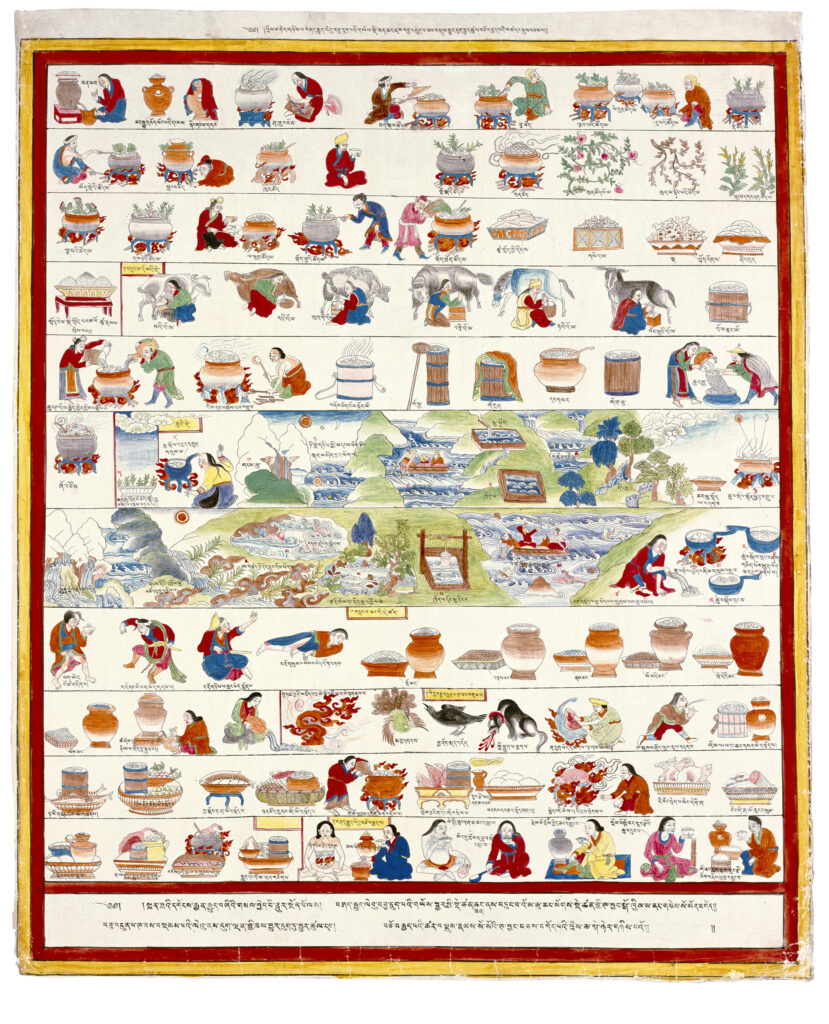Fundamentals
An introduction to the construction of medical theory and medical practice within Tibet

The Four Tantras have been the foundation of Tibetan medicine since the 12th century. These tantras describe the body within its interaction of the five elements, the three humors, and the environment. The body is in a constant flux between the humors and the elements, when there is an unbalance in the body this is how one becomes of bad health. The Four Tantras seek to remedy this unbalance through dietary and behavioral adjustments.
Fig. 5. Painting 22 of the Tibetan Medical Paintings, 20th century copy of painting dating around back to 1687-1697.
Source: Rubin Museum
Four Tantras
The four volumes dedicated to the tantras are written in a form of poetic dialogue between two sages, Rigpa Yeshe and Yilekye. Both of these sages are seen as manifestations of the Medicine Buddha. The volumes are titled respectively, Root Tantra, Explanatory Tantra, Instructional Tantra, and Last Tantra. The tantras are organized in six frameworks, which is said to be a part of the first teaching by Rigpa Yeshe to Yilekye.
The Root Tantra begins in chapters 1 and 2 relating the story on the first transmission of the tantras. The Root Tantra is described as the “seed” to which medical practices are planted.
The Explanatory Tantra has thirty-one chapters that discuss physical health, including the development of the body, the prevention and treatment of diseases, the importance of diet, the study of medications, and the overall upkeep and preservation of good health.
The Instructional Tantra is split into two parts, the first is organized in eight branches and the second is further split into ninety-two chapters. In the eight branches various types of diseases and injuries are discussed, including those affecting the body, children, and women, as well as spiritual and weapon-related injuries. Toxic substances and aging are also addressed, along with treatments for restoring vitality and fertility.
The Last Tantra discusses the four tantric volumes within twenty-five chapters. These chapters discuss the examination of pulse and urine, pacifying medications, eliminative therapy, external therapies, and concludes with a chapter on the student who can be entrusted with these teachings.
To learn more about these tantras in depth I suggest reading Bodies in Balance: The Art of Tibetan Medicine edited by Theresia Hofer.7
Humors, Elements, and The Three-fold Causes
Tibetan medicine is founded on the idea that everything, existing and non-existing, is derived from the mind and the 5 elements.8 The manifestation of the mind and the elements creates the three humors which are wind, phlegm, and bile. These humors are the basis of theory and practice within Tibetan medicine and develop the systems of the body and its functions. Each humor has a threefold cause in regards to mental predisposition, elemental energy, or physical cause. Threefold cause is when a person puts energy out into the world, good or bad, that energy will then be received by that person three times as much.
The Three-fold Causes
Mental predisposition states that marigpa, ignorance, is the source of everything. Ignorance produces three mental predispositions and delusions of the mind, this is a culmination of the parent’s physical energies.9(Table 1)

Fig. 6. Table describing how ignorance, the source of everything, affects different conditions, physical and mental, and the humors to which it is linked with.
Source: Tibetan Medicine Education Center
Elemental Energy arises from the elements energies which give way to each humor. The wind elements produce the wind humor, the fire elements produce the bile humor, a combination of water and earth elements create the phlegm humor, and ether/space is pervasive to all humans.
The last of the three-fold causes is the physical cause. The physical cause is a triple-fold dimension meaning its physical, psychic, and energetic. This cause develops the body and governs the function of the mind and body.